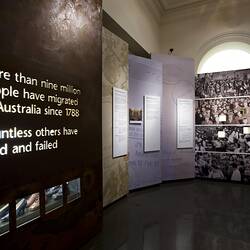Summary
Alternative Name(s): Toy Hut
Model Nissen hut of timber and tin, semi-circular, made circa 1940-1945. Made in England, it may have been brought to Australia by the donor and his family when they emigrated after World War II. The hut was acquired with SH 90.704 (toy castle). It is assumed that the dates of manufacture for the two items are the same, as this model is reminiscent of military buildings in war-time.
Building models were sometimes used for military training. For instance, the Australian War Memorial holds a set of model buildings used for Air Raid Precautions training exercises, representing a section of the northern Sydney suburb of Wahroonga (id. no. REL/12577.010).
Nissen huts were developed during World War I by Major Peter Norman Nissen of the 29th Company Royal Engineers, UK. They were used extensively by the Allies during World War II for military camps and airbases. Made simply from rolled corrugated steel, Nissen Huts were cheap to make, and easy to transport and erect.
Physical Description
Toy hut made of wood and tin. The roof has the typical appearance of corrugated iron, curved into an arch which is nailed onto wooden base and floor. One end of the hut has a large doorway cut into it. Nail ends are visible at the edges. The doorway may have originally been painted red.
Significance
World War II changed life for everyone - including children. While fathers were away fighting 'Mr Hitler', many mothers worked long hours in offices and factories. Food and clothing were rationed, and children helped grow vegetables in backyard 'victory gardens'. After Japan entered the war in 1942 and invasion threatened, the fear of bombing hung in the air. Some city children were evacuated to rural areas. Many families built air-raid shelters in suburban backyards. Trenches were dug across school playgrounds, and air-raid drills were held. Yet wartime could be exciting, too. Military marches through the city streets, fireside games of strategy and battleships, and heroic tales of soldiers in far-off lands - all lit the imagination of many a Melbourne child. But reality hit hard for those children whose loved ones did not come home. (Melbourne Story exhibition label, 2008)
More Information
-
Collecting Areas
Migration & Cultural Diversity, Public Life & Institutions, Childhood
-
Acquisition Information
Donation from D. Synott and Family, Nov 1989
-
Place & Date Made
-
Date Used
-
Inscriptions
On base: Made in England.
-
Classification
-
Category
-
Discipline
-
Type of item
-
overall dimensions
9.5 cm (Length), 10 cm (Width), 7.2 cm (Height)
-
Exhibition Collection Management
95 mm (Length), 92 mm (Width), 70 mm (Height)
-
Dimensions
100 mm (Length), 100 mm (Width), 75 mm (Height)
Measurement From Conservation. Measuring Method: maximum measurements
-
Keywords
Architectural Models, Buildings, Immigration, Military History, Scale Models, Wars & Conflicts, World War II, 1939-1945

